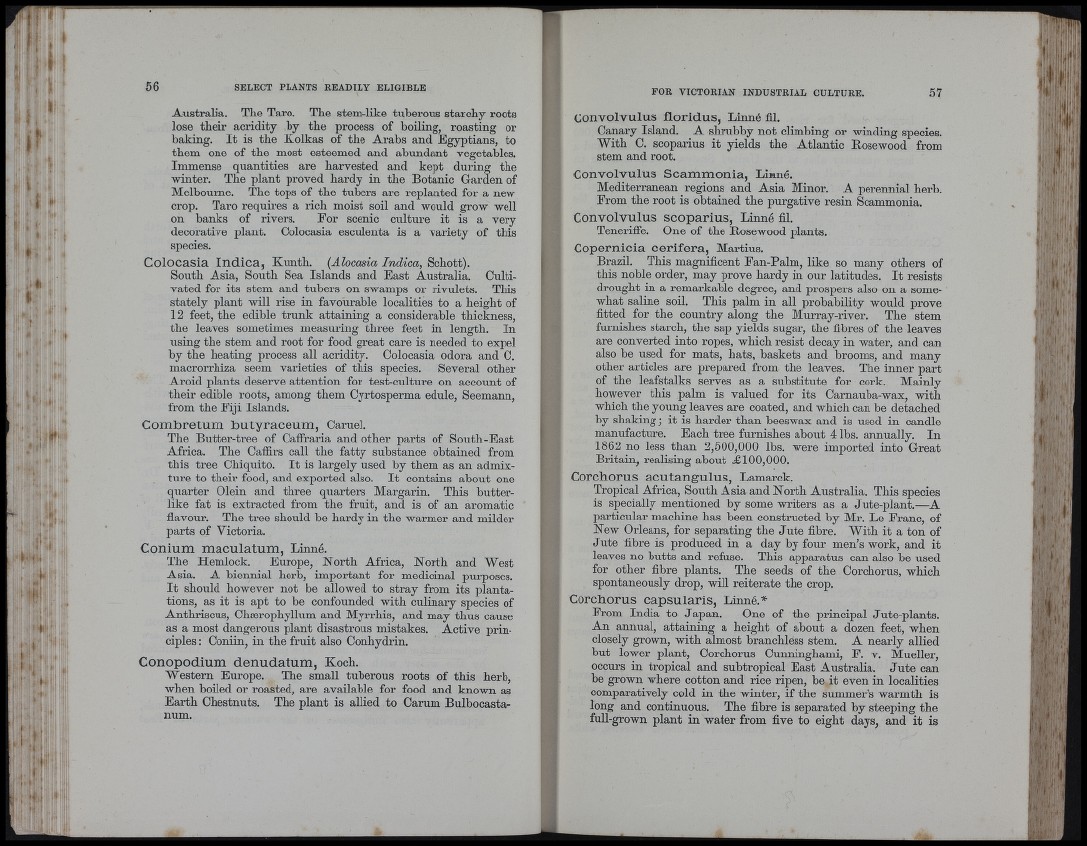
t ■ I
t. .
- *1
Australia. The Taro. The stem-like tuberous starchy roots
lose their acridity by the process of boiling, roasting or
baking. I t is the Kolkas of the Arabs and Egyptians, to
tbem one of tbe most esteemed and abundant vegetables.
Immense quantities are harvested and kept duiing the
winter. The plant proved hardy in the Botanic Garden of
Melbourne. The tops of the tubers are replanted for a new
crop. Taro requires a rich moist soil and would grow well
on banks of rivers. For scenic culture it is a very
decorative plant. Colocasia esculenta is a variety of this
species.
Colocasia Indica, Knnth. (Alocasia Indica, Schott).
South Asia, South Sea Islands and East Australia. Cultivated
for its stem and tubers on swamps or rivulets. This
stately plant will rise in favourable localities to a height of
12 feet, the edible trunk attaining a considerable thickness,
the leaves sometimes measuring three feet in length. In
using the stem and root for food great care is needed to expel
by the heating process all acridity. Colocasia odora and C.
macrorrhiza seem varieties of this species. Several other
Aroid plants deserve attention for test-culture on account of
their edible roots, among them Cyrtosperma edule, Seemann,
from the Fiji Islands.
Combretum butyraceum, Camel.
The Butter-tree of Caffraria and other parts of South-East
Africa. The Caffirs call the fatty substance obtained from
this tree Cbiquito. I t is largely used by tbem as an admixture
to their food, and exported also. I t contains about one
quarter Olein and three quarters Margarin. This butterlike
fat is extracted from the fruit, and is of an aromatic
flavour. The tree should be hardy in tbe warmer and milder
parts of Victoria.
Conium maculatum, Lmné.
The Hemlock. Europe, North Africa, North and West
Asia. A biennial herb, important for medicinal purposes.
I t should however not be allowed to stray from its plantations,
as it is apt to be confounded with culinary species of
Anthriscus, Chærophyllum and Myrrhis, and may thus cause
as a most dangerous plant disastrous mistakes. Active principles
: Coniin, in the fruit also Conhydrin.
Conopodium denudatum, Koch.
Western Europe. The small tuberous roots of this herb,
when boiled or roasted, are available for food and known as
Earth Chestnuts. The plant is allied to Carum Bulbocastanum.
C o n v o lv u lu s f lo r id u s , Linné fil.
Canary Island. A shrubby not climbing or winding species.
With C. scoparius it yields the Atlantic Rosewood from
stem and root.
Convolvulus Scammonia, Linné.
Mediterranean regions and Asia Minor, A perennial herb.
From the root is obtained the purgative resin Scammonia.
Convolvulus scoparius, Linné fil.
Teneriffe. One of the Rosewood plants.
Copernicia cerifera, Martins,
Brazil. This magnificent Fan-Palm, like so many others of
this noble order, may prove hardy in our latitudes. I t resists
drought in a remarkable degree, and prospers also on a somewhat
saline soil. This palm in all probability would prove
fitted for the country along tbe Murray-river. The stem
furnishes starch, the sap yields sugar, the fibres of the leaves
are converted into ropes, which resist decay in water, and can
also be used for mats, bats, baskets and brooms, and many
other articles are prepared from the leaves. The inner part
of the leafstalks serves as a substitute for cork. Mainly
however this palm is valued for its Carnanba-wax, with
which the young leaves are coated, and which can be detached
by shaking ; it is harder than beeswax and is used in candle
manufacture. Each tree furnishes about 4 lbs. annually. In
1862 no less than 2,500,000 lbs. were imported into Great
Britain, realising about £100,000.
Corchorus acutangulus, Lamarck.
Tropical Africa, South Asia and North Australia. This species
is specially mentioned by some writers as a Jute-plant.—A
particular machine has been constructed by Mr. Le Eranc, of
New Orleans, for separating the Ju te fibre. With it a ton of
Jute fibre is produced in a day by four men’s work, and it
leaves no butts and refuse. This apparatus can also be used
for other fibre plants. The seeds of the Corchorus, which
spontaneously drop, will reiterate the crop.
Corchorus capsularis, Linné.*
Erom India to Japan. One of the principal Jute-plants.
An annual, attaining a height of about a dozen feet, when
closely grown, with almost branchless stem. A nearly allied
but lower plant, Corchorus Cunninghami, E. v. Mueller,
occurs in tropical and subtropical East Australia. Ju te can
be grown where cotton and rice ripen, be it even in locahties
comparatively cold in the winter, if the summer’s warmth is
long and continuous. The fibre is separated by steeping the
full-grown plant in water from five to eight days, and it is
It
i,V
ii,'